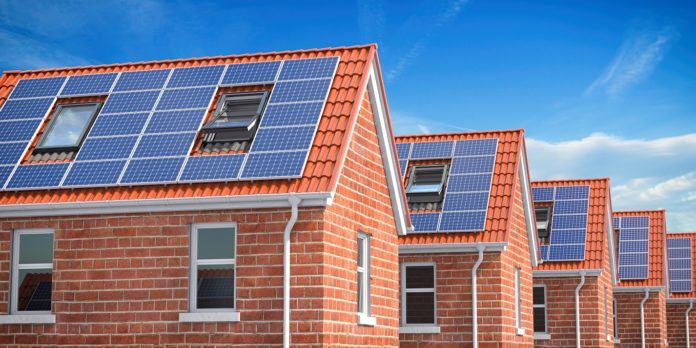While the pandemic grinded the construction sector to a halt, many homeowners decided to take the opportunity to improve their properties and in a lot of cases, make them go green.
Research from Roofing Megastore shows that the shift away from traditional options to more sustainable materials was greatly accelerated by the COVID-19 crisis.
As the nation’s builders downed tools in response to the first lockdown, it was up to homeowners to take full responsibility for sourcing materials themselves.
The company analysed the last two years of Google search data to find out which sustainable building materials, construction styles, and more were seeing the greatest growth in interest over time.
Synthetic slate comes out on top
Synthetic slate roof tiles took the lead, receiving 252% more searches in 2020 than 2019, growing almost 100% more than traditional, less sustainable concrete roof tiles.
Crafted from a mixture of recycled limestone and plastic, these sustainable roof tiles are incredibly popular amongst homeowners for their light weight, longevity, and simple installation. Other green choices sharing this growth include energy saving windows, eco-friendly insulation, cedar shingles, and rammed earth.
Top 15 sustainable building materials increasing most in popularity in 2020
| Rank | Building material | Popularity |
| 1 | Synthetic slate roof tiles | 252.48% |
| 2 | Energy saving windows | 244.58% |
| 3 | Rammed earth building | 195.98% |
| 4 | Eco friendly insulation | 179.05% |
| 5 | Cedar shingles | 176.33% |
| 6 | Ashcrete | 168.97% |
| 7 | Slate roof tiles | 165.24% |
| 8 | Green roof systems | 161.78% |
| 9 | Sheep’s wool insulation | 153.57% |
| 10 | Wood fibre insulation | 142.46% |
| 11 | Timbercrete | 135.58% |
| 12 | Hemp insulation | 132.98% |
| 13 | Recycled plastic insulation | 126.86% |
| 14 | Bamboo reinforced concrete | 116.36% |
| 15 | Precast concrete | 114.35% |
The connection between homeowners taking purchasing materials into their own hands in 2020 and making more sustainable choices for their homes is clear.
Eco-friendly concrete alternatives
The first clear category identified in the data is sustainable alternatives to traditional concrete, such as rammed earth construction. Concrete has long been favoured for its strength and low price point, however, its harmful effects on the environment cannot be denied.
In fact, if global concrete production were considered a country, it would account for 8% of the world’s CO2 emissions, coming third to the US and China. Therefore, it is not surprising that as sustainability becomes an ever-growing factor to consider when improving a property, society is beginning to seek viable alternatives.
Natural insulation
Secondly, greener forms of insulation also feature heavily on the list, as homeowners are on the lookout for less harmful ways to keep properties warm. Traditional materials such as synthetic glass mineral wool offer high levels of performance, but require large amounts of energy to produce and must be handled with care whilst wearing personal protective equipment. Natural materials such as hemp or sheep’s wool however, require very little energy to create and can be installed easily without equipment.
A wake up call for property developers
As the data shows, British homeowners have truly kicked the move towards greener solutions into gear. This trend is only going to build momentum, which means property developers and builders will have to catch up quickly if they want to get ahead of the consumer’s desire for sustainable living.
These attitudes towards the environment were echoed in a UN Development Programme poll taken last year, where 81% of Britons agreed there was a global climate emergency.
Roofing Megastore dove deeper into Google data, and uncovered an even greater shift in attitude when it came to construction in general.
Top 10 construction styles increasing most in popularity in 2020
| Rank | Construction Style | Popularity |
| 1 | Regenerative building design | 600.00% |
| 2 | Regenerative architecture | 212.24% |
| 3 | Eco friendly architecture | 158.72% |
| 4 | Eco friendly construction | 154.29% |
| 5 | Zero carbon building | 142.29% |
| 6 | Eco friendly house construction | 141.67% |
| 7 | Sustainable property development | 134.48% |
| 8 | Eco houses | 133.68% |
| 9 | Passive housing | 112.94% |
| 10 | Sustainable construction | 112.57% |
Once again, the data shows a very clear trend of greater interest in sustainable construction moving into the future, which will only continue.
Most strikingly the table showed that searches for “Regenerative building design” grew an outstanding 600%, as Britons seek to learn more about the way the built environment can be used to reverse the damage done to the eco-system, and even have a net-positive impact.
Commenting on the findings, Gian-Carlo Grossi, managing director of Roofing Megastore, said: “As COVID-19 brought our physical health to the forefront, we also had a chance to consider the health of the world around us. Last year showed homeowners turning clearly towards more sustainable alternatives for their projects, as we all seek to create a healthier, more sustainable built environment moving into the 2020s and beyond.”




